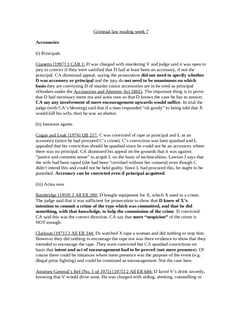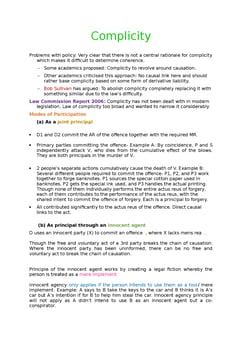R v Clarence [1888] 22 QBD 23
Judgement for the case R v Clarence
KEY POINTS
In the legal context of marriage, the considerations under Husband and Wife involve specific legal frameworks that govern the rights and responsibilities of spouses within the institution of marriage.
“Communication of venereal disease” pertains to legal cases involving the transmission of sexually transmitted infections, addressing the complexities of responsibility and consequences in such situations.
“Offences against the person” constitutes a category of crimes directly impacting individuals, covering a range of actions that cause harm, injury, or threat to an individual's well-being.
“Offences against women” focuses on criminal acts specifically directed at women, acknowledging the unique challenges and vulnerabilities that women may face within the legal framework.
The charge of "unlawful and maliciously inflicting grievous bodily harm" denotes a serious criminal offence involving the intentional and malicious infliction of severe physical harm on another individual.
"Assault occasioning actual bodily harm" refers to a criminal offence where an assailant causes tangible physical harm to the victim, constituting a specific type of assault charge within the legal system.
The reference to 24 & 25 Vict. c. 100, ss. 20, 47 points to the specific sections of the 24th and 25th Victories, chapter 100, which contain legal provisions directly related to the criminal offences discussed, offering a basis for applying relevant laws and regulations.
FACTS
Charles James Clarence (‘Accused’) was found guilty based on an indictment that accused him of "unlawfully and maliciously inflicting grievous bodily harm" upon Selina Clarence (‘His wife’) and of committing "an assault" leading to "actual bodily harm." These charges were brought under sections 20 and 47 of the 24th and 25th Victories, chapter 100.
The circumstances revealed that, at a certain point, the accused was aware of his infection with gonorrhoea, a fact unknown to His Wife. Despite this knowledge, the Accused engaged in intimate relations with His Wife.
As a consequence of this act, the sexually transmitted disease was transmitted to his wife. Importantly, it was established that had she been informed of his medical condition, she would not have consented to the sexual intercourse.
JUDGEMENT
The court, comprising Lord Coleridge, C.J., Pollock, and Huddleston, BB., Stephen, Manisty, Mathew, A. L. Smith, Wills, and Grantham, JJ., unanimously held that the actions of the Accused did not amount to an offence under either section of the statute.
In the judgment, it was concluded that the conviction must be quashed.
However, it is noteworthy that Field, Hawkins, Day, and Charles, JJ., dissented from this decision.
COMMENTARY
The case in question involves a complex interplay of criminal charges, namely, "unlawfully and maliciously inflicting grievous bodily harm" and committing "an assault" resulting in "actual bodily harm," as outlined in sections 20 and 47 of the 24th and 25th Victories, chapter 100. The actions of the Accused were rooted in the concealment of his gonorrhoea infection from his wife, leading to the transmission of the disease during intimate relations. The critical element in the case was the revelation that had the wife been aware of her husband's medical condition; she would not have consented to the sexual intercourse.
In rendering judgment, the court, comprising a panel of distinguished judges including Lord Coleridge, C.J., Pollock, and Huddleston, BB., Stephen, Manisty, Mathew, A. L. Smith, Wills, and Grantham, JJ., unanimously held that the conduct of the Accused did not constitute an offence under either section of the statute. The decision to quash the conviction underscores the court's assessment that the legal elements required for a conviction were unmet in this case.
It is noteworthy, however, that dissenting opinions were expressed by Field, Hawkins, Day, and Charles, JJ. The dissent suggests a divergence of legal interpretation or perhaps a nuanced disagreement on applying the law to the case's specific circumstances. Such dissension adds a layer of complexity to the legal discourse surrounding the actions of the accused and the charges brought against him. The case highlights the nuanced nature of legal decisions and the impact of individual perspectives within the judicial process.
ORIGINAL ANALYSIS
A man had gonorrhoea, though he knew and didn’t tell his wife, and had sex with her, passing it onto her and causing her injury.
He was convicted of GBH (grievous bodily harm) under s.20 and occasioning actual bodily harm under s.47 by jury.
HL allowed his appeal.
LJ Wills
Said that consent is still consent even if not informed, e.g. if a prostitute accepts bad money for sex, she does not fail to consent to sex as such a proposition would be “childish”.
LJ Stephen
Says that fraud does not always vitiate consent since in a case since a man with two wives would always be held guilty of rape if the second wife would not have had sex with him had she known that he had a first wife.
This does not mean he was raping her each time he had sex with her.
(Surely the argument is not that he raped her but that he committed GBH, which he did since he caused her serious illness and did so maliciously i.e. with full awareness of what could happen. The assault he inflicted upon her, as stated by LJ Hawkins, was that he had sex with her when she was in danger of serious illness, which case law establishes as illegal. Assault is a crime regardless of consent, consent being immaterial in sexual relations between man and wife. He assaulted her (consent does not matter), he did so maliciously and he inflicted serious wounds on her and therefore ought to be found guilty).
NOTE: This is obviously no longer good law.
RELATED CASES
For Further Study on R v Clarence

Criminal Law notes fully updated for recent exams at Oxford and Cambrid...
Need instant answers? Our AI exam tutor is here to help.
Ask questions 🙋 Get answers 📔 It's simple 👁️👄👁️
Our AI is educated by the highest scoring students across all subjects and schools. Join hundreds of your peers today.
Get StartedRelated Product Samples
These product samples contain the same concepts we cover in this case.
| Criminal Law | Non Fatal Offences Short Notes (11 pages) |
| Criminal Law | Non Fatal Offences Against The Person Notes (17 pages) |
| Criminal law | Offences Against The Person Notes Real Notes (28 pages) |

 Since 2010, Oxbridge Notes has been a trusted education marketplace, supplying high-quality materials from top achievers at universities like Oxford, Cambridge, LSE, Harvard, and Yale.
Since 2010, Oxbridge Notes has been a trusted education marketplace, supplying high-quality materials from top achievers at universities like Oxford, Cambridge, LSE, Harvard, and Yale.